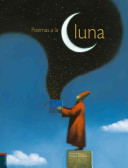
This collection includes works by world-renowned poets, among them Lorca, Goethe, Whitman, and Shelley. Each poem appears first in Spanish, and then in its original language, if the poem was translated. For instance, Emily Dickinson’s selection appears in Spanish and English, while Wang Wei’s appears in Spanish and Chinese. The book opens with an excerpt from Christina Rossetti’s Is the Moon Tired? in which the orb is personified as a tired, hardworking woman. Its Spanish translation actually sounds more musical than the original English. The hauntingly beautiful full-page digital paintings have an ethereal quality that transports readers into the lyrical poetry. The Moon appears in each illustration, sometimes as a crescent, sometimes full, and sometimes as a woman’s face. This oversize treasury will be perfect for a world-poetry unit, a lesson on the art of translation, or special poetry programs at schools and libraries.–Rebecca Hickman, Sherman Library at NSU, Fort Lauderdale, FL
- ISBN: 9788426373380
- Published: 2009 , Luis Vives Editorial
- Themes: Language, Moon, Poetry, Spanish
- Descriptors: Poetry, Primary (ages 6-9)
- No. of pages: 28

I first saw Poemas a la luna at the public library displayed in the children’s section. I was immediately drawn to this tall book with intriguing cover art. Soothing shades of a blue sky with white clouds is the backdrop to a mysterious man dressed in red robes subtly shadowed. He stands on a green block or perhaps it is a chimney, opening a blue box covered with stars and crescent moons. Out of this box, the night black sky with glittery stars and a crescent moon swirl into the blue sky.
Opening the book, I find a piece of crescent moon sweeping across the end pages, inviting me to turn the page. On that next double-paged spread, the title page, I see a glowing, full moon; and in the center of that moon, another full moon, but this one with a face. I find this face to be startling, the eyes not as I expect. I turned the page again. This time, in the shadowy night is a crescent moon, a woman astride a winged horse, and trees with stars for leaves. In between the stars, a poem by Christina Georgina Rosetti:
“Está la luna cansada? Se la ve tan blanquecina
tras su toca mortecina:
asciende al firmamento de oriente a occidente
sin parar a descansar en ningún frente.
Antes de que la noche se torne oscura
la luna muestra su blancura;
y, luego, antes del amanecer,
decide desaparecer.”
Then in smaller print right below:
Is the moon tired? She looks so pale
Within her misty veil:
She scales the sky from east to west
And takes no rest
Before the coming of the night
The moon shows papery white;
Before the dawning of the day
She fades away
The misty illustration invoked a quiet peace as I read the poem in Spanish and then in English–the visual and written texts in harmony. I turn the page. This time, against the night sky, I see the woman walking past four archways. As she passes by the first arch, she begins to fade until she cannot be seen in the final arch. Through the top of each arch, a different moon appears–full, half, crescent, and then a thin over-articulated crescent. This time, an Emily Dickinson poem is featured, first in Spanish and then in English. Again, I turn the page. A shadowy horse and rider cross the pages with a luminescent profile in the clouds above, a poem by Goethe. This exquisitely illustrated book flows from page to page with sweeping shapes, cool, dark colors, and odes to the moon. I literally catch my breath with the “visualness” of each poem and know I must get this book….
T. Gail Pritchard, Ph.D.
University of Alabama Huntsville
January 3, 2012